 |
[ Outlaw Genealogy | Bruce
History | Lost Chords ] [ Projects | News | FAQ | Suggestions | Search | HotLinks | Resources | Ufo ] |
 |
[ Outlaw Genealogy | Bruce
History | Lost Chords ] [ Projects | News | FAQ | Suggestions | Search | HotLinks | Resources | Ufo ] |
So I have missed this - explaining and investigating the symbolic meaning behind the heraldic arms of the Outlaw's . Here I will explain how it shows the Outlaw's history connections to the crusades and early English, Irish and Norman royal families ...
Also not often thought of but the Conquest of England in 1066 was actually a crusade by the Latin Pope to make England and Ireland Roman Catholic. William was financed and given Papal Bull to make England Roman Catholic .
First understand where the arms came from, that the arms were first documented and given in 1563 under the reign of Queen Elizabeth I . And then again in 1613. Also it is documented that these arms were used BEFORE 1563 .
Now lets start with the saltire gules ( The RED X ) ... This symbolizes CHRISTIAN ARMS, the X is short for CHi-Ro as X-Mas is short for Christmas . This may also indicate these families went on Christian crusades. It also is symbolic of Saint Andrews Cross .
It is also interesting that the Red X Arms were used in Ireland by the Sons of Gerald, ie Geraldines ie FitzGeralds ... which were crusading families ... and may indicate a relationship to the De Clare's, de Burgh's, Geralds, Pembrokes de Vere, and so on.
The background of Silver/Argent : Signifies truth, sincerity, peace, innocence and purity
The Wolves heads is symbolic for Outlaw in canting arms ( ie a PUN) , Why Four heads? This maybe symbolic for the four evangelists, Matthew, Mark, Luke and John, with Christ in the center Christianity (central cross) as in a Jerusalem Cross (see below) the Crusader's Cross - the coat of arms of the short-lived Jerusalem Kingdom (1099-1203 AD).
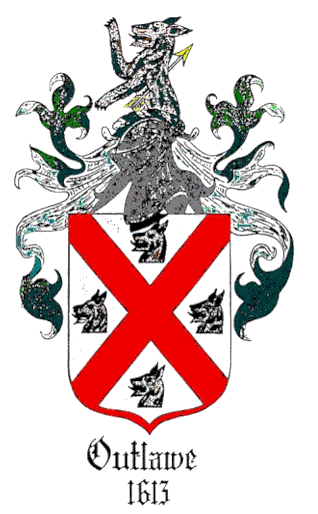
The Wolf was a respected animal to the Anglo-Saxons, it symbolizes loyalty, power and freedom
ARMS Argent a saltire gules between four wolves' heads couped proper.
CREST
A demi-wolf proper wounded in the shoulder by an arrow or head and
feathers argent embrued gules. (British Museum-Stowe).
Ancient Translations:
ARMS Silver: a red saltire between four wolve's heads severed and in natural color.
CREST One half a wolf couped proper pierced through the side with a gold
arrow, feathered and headed in silver. the arrow lying bent to the right.
Arms: On a saltire, between four wolves' heads
couped, a crescent
(Outlaw of Little Witchingham, co. Norfolk, granted 1613, Argent, a
saltire gules between four wolves' heads, couped proper.)
Crest: A demi-wolf, pierced through the side with an arrow, feathered and headed,
the arrow lying sinister bend ways (Outlaw, A demi-wolf proper, pierced
through the side with an arrow or, feathered and headed argent, the arrow
lying sinister bendways.)
College of Arms is the official repository of the coats of arms and pedigrees of English, Welsh, Northern Irish and Commonwealth families and their descendants.
Chi Rho “X” is actually indicating the Greek letter “Chi”,
which is short for the Greek![]() ,
meaning “Christ”.
,
meaning “Christ”.
So “Xmas” and “Christmas” are
equivalent in every way except their lettering.
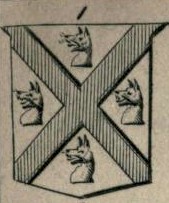
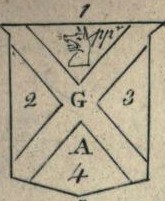 Page 59, 61
Page 59, 61
A
short and easy introduction to heraldry, in two parts ..
by Clark,
Hugh, fl. 1775-1784
Published 1827
The Sons of Gerald ....
There once was a Welsh priest called Gerald
Giraldus’ scholarly abilities should not be allowed to obscure the fact that his loyalties lay firmly with the Norman establishment. Not only was he the son of William de Barri, a Welsh/Norman lord, but his maternal grandmother was Nest, a Welsh princess and mistress of King Henry I, whose children founded the Fitzstephen, Fitzgerald and Fitzhenry families. Therefore, Giraldus was closely related to many of the invasion’s key figures. These included various cousins; his brothers Robert and Phillip; his paternal half brothers, the de Cogans; and his mother’s brother, Maurice Fitzgerald, founder of the powerful Geraldine dynasty, whose descendants later held the Earldoms of Offaly, Kildare, and Desmond, and Duchy of Leinster.
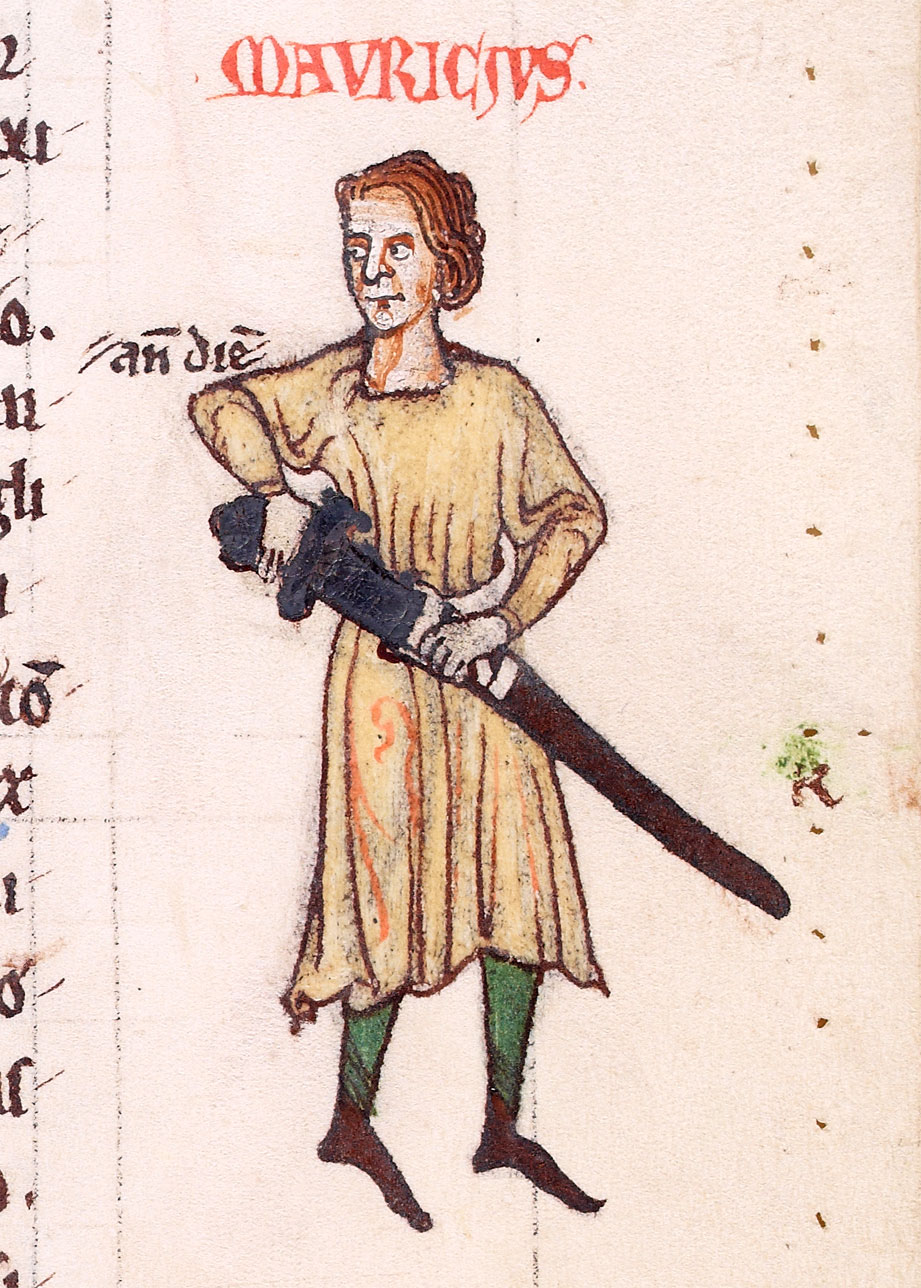
This is Giraldus' Uncle Maurice - Maurice Fitzgerald, founder of the powerful Geraldine dynasty. It is fascinating to see how the (most likely) silver pigment of Maurice's sword has blackened over the centuries, and also the pricking holes to the right of him which were used by scribes to mark up ruling lines for the text. NLI ref. Ms. 700
| - - - - -
Re FitzGERALD in the Crusades - Genealogy.com
Yes, the FitzGeralds absolutely participated in the Crusades along
with all of the great European families.
...
You could scarcely have kept the FitzGeralds away from the First Crusade
except that their origin was slightly later as the marriage of Nest Tudor, a
Welsh princess, to Gerald of Windsor which produced William the progenitor of
the FitzGeralds in 1095 would have made him at most about four years old when
the Latin Kingdom of Jerusalem was established Christmas Day 1100;however, I
think you will find that, beginning with this William, the FitzGeralds were
active participants in everything thereafter from the Norman conquest of Ireland
to the later Crusades.
...
| - - - -
Juliana FitzGerald, Lady of Thomond - (12 Apr 1266 - 29 Sep 1300) was a Norman-Irish noblewoman, the daughter of Maurice FitzGerald, 3rd Lord of Offaly, and the wife of Thomas de Clare, Lord of Thomond, a powerful Anglo-Norman baron in Ireland, who was a younger brother of Gilbert de Clare, 6th Earl of Hertford. Juliana was married three times; Thomas being her first. She is sometimes referred to as Juliane FitzMaurice.
...
In 1278, at the age of 12, Juliana married her first husband, Thomas de Clare, Lord of Inchiquin and Youghal. He was the second eldest son of Richard de Clare, 5th Earl of Hertford, 2nd Earl of Gloucester and Maud de Lacy. Thomas was a friend of King Edward I of England, with whom he went on a Crusade. He held many important posts including the Office of Governor of Colchester Castle (1266), Governor of the City of London (1273). He was also the commander of the English forces in Munster, Ireland, and on 26 January 1276, he was granted the lordship of Thomond
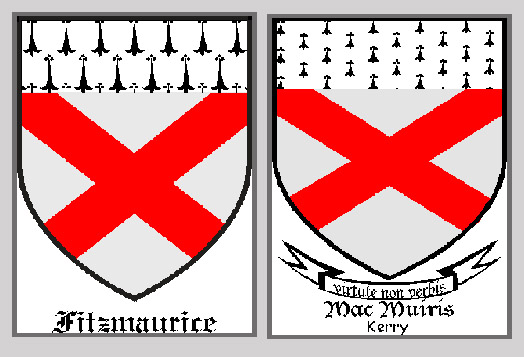
- -- - -
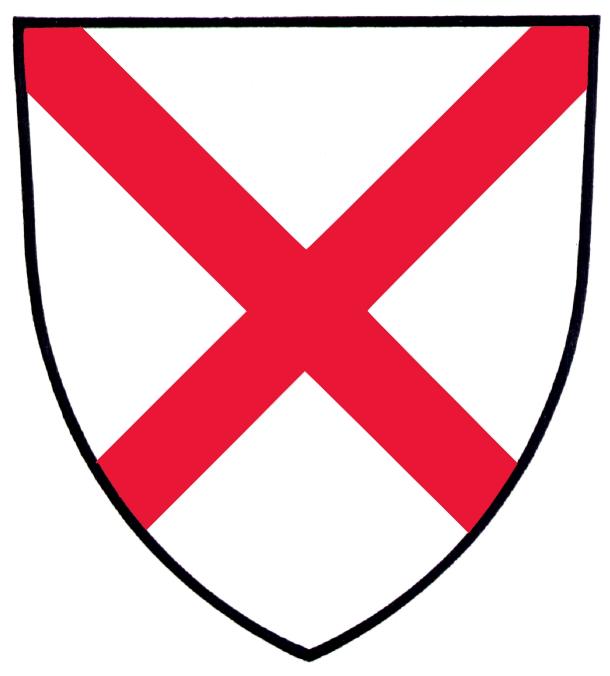
This
coat of arms seems to have been abandoned by his grandson (through his
eldest son Gerald) or his youngest son, both called Maurice FitzGerald
(IV and III), the latter Justiciar of Ireland for the year 1272.
The new coat of arms is described in Walford’s Roll (1275) as: Morice
le FitzGerald, d'argent un sautoir de gulez,
and in Camden Roll (1280): Munsire Moris le FizGeroud, l'escu de argent a un
sautur de gules. [30]
The heritage of MauriceFitzGerald (IV), the “heir male and head of the
race” was the nucleus of the Earldom of Kildare of his heir John FitzThomas,
who was granted the Earldom in 1316. His successor Maurice
FitzGerald FitzThomas, the 4th earl (*1318-†1390)
bore, at the siege of Calais 1345-‘48: argent a saltire gules. and we
may conclude from this that the arms with the saltire in Camden and Walford’s
Roll’s were actually the arms of Maurice FitzGerald (IV).[31]
---------
Now much later: which shows the connection I am trying to look at:
1326 - William
fitz Maurice marries Margaret Outlawe daughter of William Outlawe,
the banker of Kilkenny - Williaim
fitz Maurice, son of Maurice fitz Maurice, succeeds his father, services due
to Richard de Clare, Earl of Gloucester and Hertford in the county Kilkenny,
- later known as the " Maurice Fitgerald 's "
So if we try to peer into the beginnings .. at the early families crusading post conquest ... with connections to the De Clares, Geralds, De Vere , Pembroke Wales and Ireland ..
Ralph de Gael - otherwise Ralph de Guader, Radulf Waders or Ralph Wader) (before 1042 – c. 1096) was the Earl of East Anglia (Norfolk and Suffolk) and Lord of Gaël and Montfort (Seigneur de Gaël et Montfort). He was the leading figure in the Revolt of the Earls, the last serious revolt against William the Bastard.
...
Ralph was born before 1042, most probably about 1040 in Hereford,
as not later than 1060 he attested, in company with other Bretons,
a notification at Angers as son of Ralph
the Staller.
....
In 1066 he fought on the Norman side at the Battle
of Hastings.
...
He married, in 1075 at Exning, Cambridgeshire, Emma,
only daughter of William
FitzOsbern, 1st Earl of Hereford and his first wife Alice or Adelise (or
Adelissa), daughter of Roger I of Tosny
...
In 1075 the king's refusal to sanction this marriage
between two powerful families caused a revolt in his absence. The leaders
were Ralph, his new brother-in-law Roger
de Breteuil, 2nd Earl of Hereford, and Waltheof,
1st Earl of Northumberland. The revolt was plagued by disaster
...
Ralph, formerly Earl of Norfolk and Suffolk (East
Anglia) and his Countess Emma retired to her Breton lands. They left for the
Holy Land, joining Robert, Duke of Normandy, on the First Crusade, and died
circa 1101.
;...
In 1096, accompanied by his wife and under Robert Curthose, he went on Crusade. He was one of the Breton leaders who took part in the siege of Nicaea, after which he joined Bohemund I of Antioch’s division of the army.
Both Ralph and his wife Emma died on the road to Palestine in the course of the Crusade.
...
Now the connection is this ...Earl Ralph would have had his followers and they would have then followed Robert Curthose ! and its connection to Wales of Cardiff Castle ... There is also another connection in Edgar the Atheling who also traveled and supported Robert Curthose.
Robert Curthose - (c. 1051 – 3 February 1134), sometimes styled Robert II or Robert III, was the Duke of Normandy from 1087 until 1106 and an unsuccessful claimant to the throne of the Kingdom of England.
Robert was the eldest son of William the Conqueror, the first Norman king of England, and Matilda of Flanders, and a participant in the First Crusade. His reign as Duke is noted for the discord with his brothers in England, eventually leading to the absorption of Normandy as a possession of England ...
In 1106, Henry defeated Robert's army decisively at the Battle of Tinchebray and claimed Normandy as a possession of the English crown, a situation that endured for almost a century. Captured after the battle, Robert was imprisoned in Devizes Castle for twenty years before being moved to Cardiff.
In 1134, Robert died in Cardiff
Castle in his early eighties. Robert Curthose, sometime Duke of
Normandy, eldest son of the Conqueror, was buried in the abbey church of St.
Peter in Gloucester.
...
Robert also had at least three illegitimate children – Richard, who
died hunting in the New Forest in May
1100,[a] a son William, a full brother of Richard,[4]
and a daughter who married Helias
of Saint-Saens.[5] William went to
Palestine after 1106 and was named lord of Tortosa, but disappears from the
historical record after 1110.[6]
| - - - - - - - -
Edgar the Ætheling
- (c. 1051 – c. 1126) was the last male member of the royal house of Cerdic of Wessex (see House of Wessex family tree). He was proclaimed, but never crowned, King of England in 1066.
...
...
William kept Edgar in his custody and took him, along with other English leaders, to his court in Normandy in 1067,
before returning with them to England. Edgar may have been involved in the abortive rebellion of the Earls Edwin and Morcar in
1068 or he may have been attempting to return to Hungary with his family and been blown off course; in any case, in that year he arrived with his mother and sisters at the court of King Malcolm III Canmore of Scotland. Malcolm married Edgar's sister Margaret and agreed to support Edgar in his attempt to reclaim the English throne
...
in 1085 Edgar secured the king's permission to emigrate with a retinue of two hundred knights, to seek his fortune in the expanding Norman colony in southern Italy and
Sicily. He set out in 1086. The venture in the Mediterranean was evidently not a success; within a few years Edgar returned to England.
...
After King William's death in 1087 Edgar supported William's eldest son Robert
Curthose, who succeeded him as Duke of Normandy, against his second son, William Rufus, who received the throne of England as William II.
...
Orderic tells us that Edgar was the commander of an English fleet which operated off the coast of the region of Syria in support of the First
Crusade, whose crews eventually burned their dilapidated ships and joined the advance by land to
Jerusalem. This is doubtful, as this fleet is known to have arrived off the Syrian coast by March 1098: since Edgar invaded Scotland late in 1097, he could not have made the voyage in the time available. It may be though that he travelled overland to the Mediterranean and joined the fleet en route; this is the view taken by Runciman.[17]
William of Malmesbury recorded that Edgar made a pilgrimage to Jerusalem in 1102,
and it may be that Orderic's report is the product of confusion, conflating the expedition of the English fleet with Edgar's later journey.
...
Back in Europe, Edgar again took the side of Robert Curthose in the internal struggles of the Norman
dynasty, this time against Robert's youngest brother who was now Henry I, King of England. He was taken prisoner in the final defeat at the
Battle of Tinchebray in 1106, which resulted in Robert being imprisoned for the rest of his life.
Edgar was more fortunate: having been taken back to England he was pardoned and released by King
Henry.[19][non-primary source needed] His niece Edith (renamed Matilda), daughter of Malcolm III and Margaret, had married Henry in 1100.
...
| - - - -
1207 - Hubert
de Burgh purchased of Roger de Burnham and Julian, his wife, William
de Noiers, Robert Fitz Ralph, and Alice his wife, and Robert de
Utlagh, their several nine parts of two knights fees in Runton and
Beeston and Hinderingham, for which they paid castle gaurd to Dover.
9th of King John * The
Norfolk antiquarian miscellany - West
Runton - Beeston Regis
- Hindringham - "Hindringham
Outlagh Manor"
1207 - Alan
the son of Robert de Vtlage,
Hubert de Burgh, 1st Earl of Kent
- (c. 1170 – before 5 May 1243) was Justiciar
of England and Ireland and one of the most influential men in England
during the reigns of King John
(1199–1216) and of his infant son and successor King Henry
III (1216–1272).
...
De Burgh's family were minor landholders in Norfolk
and Suffolk, from whom he inherited at
least four manors.[1] His mother was named
Alice, and his father may have been named Walter.[1]
He was the younger brother of William
de Burgh (d. 1206),[2] the founder of the de
Burgh/Burke/Bourke
dynasty in Ireland. His younger brother
Geoffrey was Archdeacon of Norwich
and then Bishop of Ely, and his younger
brother Thomas was castellan of Norwich.
| - - - - - - -
1150~1169 - Charter of Bartholomew de Glanville To Bromholme Priory - Walteri Utlage - Bromholm Priory
Siege of Lisbon
- from July 1 to October 25, 1147, was the military action that
brought the city of Lisbon
under definitive Portuguese control and expelled its Moorish
overlords
...
On May 19, 1147, a contingent of crusaders left from Dartmouth
in England, consisting of Flemish,
Frisian,
Norman, English,
and Scottish
crusaders, and some from Cologne,[7]
who collectively considered themselves "Franks".[8]
No prince or king was in charge of the expedition, and its participants seem to
have been largely made up of townsmen, who organised themselves using a sworn
oath.[2]
Leadership was provided by Hervey
de Glanvill, Constable of Suffolk.[9][10]
Other crusader captains included Arnold III of Aerschot, Christian of Ghistelles,
Simon of Dover, Andrew of London, and Saher of Archelle,[11]
but important decisions were taken collectively.
...
Hervey de Glanvill
- (fl. c.
1140–50) was an Anglo-Norman
nobleman and military leader. He was a scion of a younger line of the
Glanvill family, which had been established in East
Anglia, especially Suffolk,
since before 1086. He had several sons and daughters, the most prominent of
which was Ranulf
de Glanvill, who became justiciar of England
..| - - - -
Robert de Vere, 3rd Earl of Oxford - (after c. 1165 – before 25 October 1221), hereditary Master Chamberlain of England,[1] was son of Aubrey de Vere, 1st Earl of Oxford, and Agnes of Essex.
De
Vere - The De Vere Family
The family name of de Vere is believed to have come from the small town of Ver, near Bayeaux in Normandy.
They may also be
decended from a Breton family from Vair, near Nantes. Their early history is surrounded in mystery.
The arms of the de Vere family are described as “Quarterly gules and or, in the first quarter a mullet argent” which means a shield with
the first and fourth quarters red, the second and third quarters gold and a silver five pointed star in the first quarter.”
Aubrey II de Vere went on the First Crusade in 1098, and it was at this point that the star was added to the coat of arms. According to legend, darkness was
falling over the battlefield, and it appeared the saracens would be saved. However, a brilliant star appeared on Aubrey de Vere’s
banner to illuminate the field. The battle continued, the Crusaders were victorious, and the star became a permanent part of the Arms of de Vere.
Aubrey de Vere II - (c. 1085 – May 1141)
Argent is Silver
In heraldry, argent is the tincture of silver, and belongs to the class of light tinctures, called "metals". It is very frequently depicted as white and usually considered interchangeable with it. In engravings and line drawings, regions to be tinctured argent are either left blank or indicated with the abbreviation ar. in them.
Silver / White – Argent: Signifies truth, sincerity, peace, innocence and purity
1563 - Outlaw, of Wichingham - a saltier between 4 wolves' heads - erased gules - Coat Armour used in Norfolk Before 1563 - [ Canting arms - are heraldic bearings that represent the bearer's name in a visual pun or rebus ] - Outlaw ... ... Wolves' heads. [ Pun - An Outlaw is like a Wolf's Head ]
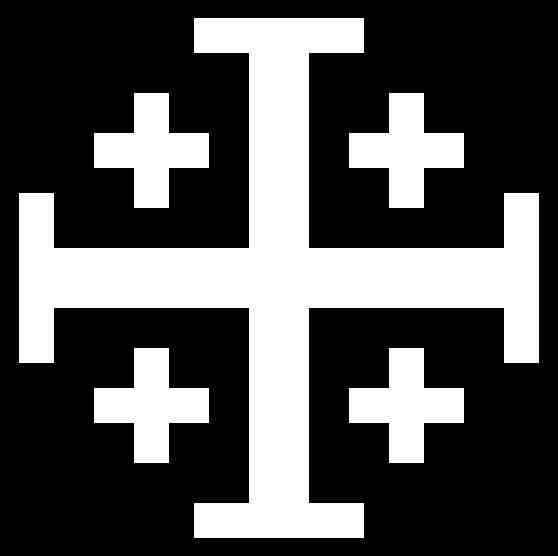
The History and Meaning of the Jerusalem Cross, or the Crusader's Cross - This Jerusalem cross represents Christ's command to spread the Gospel around the world, a mission that started in Jerusalem.
The four evangelists, Matthew, Mark, Luke and John, with Christ in the center
Christianity (central cross) broadcast by missionaries to the four corners of
the world
Five crosses representing the five wounds of Jesus on the cross (small crosses
for the hands and feet, and the large central cross for the spear wound in His
side
Jerusalem cross - The design originates with the coat of arms worn by Godfrey of Bouillon during the First Crusade, and it remained in use as the armorial of the Kingdom of Jerusalem throughout its duration (1099–1291)
Andrew the Apostle - from the early 1st century – mid to late 1st century AD), also known as Saint Andrew and called in the Orthodox tradition Prōtoklētos (Πρωτόκλητος) or the First-called, was a Christian Apostle and the elder brother of Saint Peter
The name "Andrew" (Greek:
manly, brave, from ἀνδρεία, Andreia,
"manhood, valour"), like other Greek names, appears to have been
common among the Jews,
Christians,
and other Hellenized
people of Judea.
No Hebrew
or Aramaic
name is recorded for him. According to Orthodox tradition, the apostolic
successor to Saint Andrew is the Patriarch of Constantinople.
...
Andrew is said to have been martyred
by crucifixion
at the city of Patras
(Patræ) in Achaea.
Early texts, such as the Acts of Andrew known to Gregory
of Tours,[11]
describe Andrew as bound, not nailed, to a Latin
cross of the kind on which Jesus is said to have been crucified; yet a tradition
developed that Andrew had been crucified on a cross of the form called crux
decussata (X-shaped cross, or "saltire"), now commonly known
as a "Saint
Andrew's Cross" — supposedly at his own request, as he deemed
himself unworthy to be crucified on the same type of cross as Jesus had been.[12]
The iconography
of the martyrdom of Andrew — showing him bound to an X-shaped cross —
does not appear to have been standardized until the later Middle
Ages
For Reference:
The Antiquities of Heraldry Collected from the Literature, Coins, Gems ... - William Smith Ellis
Antiquities of Heraldry,
COLLECTED FROM THE LITERATURE, COINS, GEMS, VASES, AND OTHER MONUMENTS OF PEE-CHEISTIAN AND MEDIAEVAL TIMES;
WITH A CATALOGUE OF Early Armorial Seals:
TENDING TO SHOW THAT MODERN HERALDRY EMBODIES OR IS DERIVED FROM THE RELIGIOUS
SYMBOLS, THE MILITARY DEVICES, AND THE EMBLEMS OF THE HEATHEN DEITIES OF ANTIQUITY.
BY WILLIAM SMITH ELLIS, ESQ.
OF THE MIDDLE TEMPLE.
They leave out of view the ensigns which distinguished the subdivisions of a tribe, and confine their attention to the tribe standards : and in this it will be well to follow their example. They by no means agree among themselves ; the
Rabbins suppose that the standards of the Jewish tribes were flags, bearing figures derived from the comparisons used by Jacob in his final prophetic blessing on his sons. Thus they have Judah represented by a lion, Dan by a serpent,
Benjamin by a wolf, etc.
..
16
Matthew Paris informs us that in the Crusade under Richard Coeur de Lion and Philip Augustus, the French were distinguished
by red crosses, the English by white, and the Flemish by green.
All maritime nations have always had certain marks, signs, or colours to distinguish their vessels. We read in Ezekiel (xxvii. 7)
" Fine linen with broidered work from Egypt was that which thou spreadest forth to be thy sail ; blue and purple from the isles of
Elishah was that which covered thee." Pliny tells us that the stern and prow of trading vessels and men of war were without exception
decorated with colours ; and at Athens, Corinth, and Sicyon, the profession of ship-painters founded the famous school of painters in
those cities. The savages of the Pacific and South Seas made use of distinctive signs. Woven reeds were used for sails, and rushes
for streamers,—hence the word flag.
...
72
I now propose therefore to show the bearing of Heraldry on Mythology. Indeed, when
investigation shows that there is scarcely any ancient heraldic charge or bearing that is not found amongst the symbols of the religions of
antiquity, this connection requires no demonstration. But what has never before been attempted, is to
show that almost all these emblems connected with mythology had originally a purely heraldic significance, that is, were the chosen marks or insignia of warrior chieftains, and subsequently became of sacred and mystic import.
...
105
HERALDIC ORIGIN OF MANY FAMILY AND LOCAL NAMES.
A cursory examination of languages shows that names derived from the animal kingdom enter largely into the
composition of personal and local nomenclature.* This * Sing in Sanskrit means Lion, and is the suffix in many Hindoo
names, as Runjeet-Sing, etc. Sang in Gaelic means the same thing.
Among the Romanized Britons, the lion gave rise to such names as LLeurwellyn, etc.
The Greek and Roman names into which it enters
are numerous : as Leocrates, Leodamas, Leon, Leonatus, Leonidas, Leander, etc.
In the Teutonic language, we have Leonard, Leopold, Leowulf, Leofric, etc. In Denmark names derived from it are abundant, as Lowenharz, Lowenstern, etc.
And this is accounted for, as the Anglo-Norman nobility of Danish descent principally bore lions in their arms.
In Saxon England, names of persons or
places into which the word lion enters are rare, if not entirely wanting, whilst those animals as the fox, deer, swan, goat, bear,
wolf,
etc., which are heraldic ensigns amongst the Germans, and which do not occur amongst those of the Anglo-Normans, enter plentifully
into the local nomenclature of the Saxon settlements.
...
208
But that the Saltire was an ancient Scottish or Saxon ensign seems
probable. Robert de Brus who died 1141 obtained the grant of Annandale.
His descendants bore a saltire as the basis of their arms, apparently as the ensigns of this
fief. It is given as the ensign of Offa king of Mercia in the 9th century ; and
might have been that of Waltheof Earl of Northumberland in the 10th
century.
It never seems to have been so common as the cross of St.George, nor as the lion or many other bearings :
it is only found once in the list of arms of the Crusaders at Versailles, and in
England the earliest instances met with are in the roll of Henry III (1240-5) where there are only three coats of this
bearing, whilst in the Roll of Edward II the proportion is 28 coats to 92 of Crosses of all kinds.
The following table will show the prevalence of the Saltire amongst numerous families who had a common origin :—
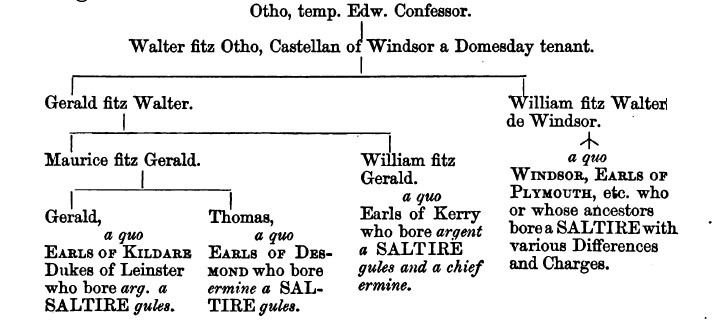
...
Some early documented Outlaw family associations with crusading families: (esp. De Vere, Baillol, De Burgh)
1150~1169 - Charter of
Bartholomew de Glanville To Bromholme Priory - Walteri Utlage - Bromholm
Priory
1207 - Hubert
de Burgh purchased of Roger de Burnham and Julian, his wife, William
de Noiers, Robert Fitz Ralph, and Alice his wife, and Robert de
Utlagh, their several nine parts of two knights fees in Runton and
Beeston and Hinderingham, for which they paid castle gaurd to Dover.
9th of King John * The
Norfolk antiquarian miscellany - West
Runton - Beeston Regis
- Hindringham - "Hindringham
Outlagh Manor"
1207 - Alan
the son of Robert de Vtlage,
1285 - Charter of Ida daughter of the late Richard Utlaw - five acres of land and half an acre of meadow, with appurtenances. - Roger [ son of Richard ] Outlaw ( of Bumpstead Helion ), Ida daughter of Richard ( Hospitallers Cart. Maplestead Essex)
1326 - William
fitz Maurice marries Margaret Outlawe daughter of William Outlawe,
the banker of Kilkenny - Williaim
fitz Maurice, son of Maurice fitz Maurice, succeeds his father, services due
to Richard de Clare, Earl of Gloucester and Hertford in the county Kilkenny,
- later known as the " Maurice Fitgerald 's "
---- >>> Back to Outlawe Home